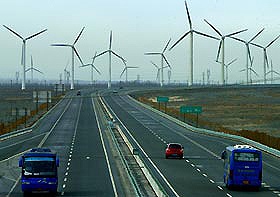China may emerge as world top wind power
Greenpeace on Monday called for greater
investment in wind turbines in China, the world's top coal consumer, saying
Beijing's ambitious target for renewable energy means it could emerge the global
top wind power by 2020.

A wind power plant in Dabancheng
Greenpeace on Monday called for greater investment in wind turbines in China, the world's top coal consumer, saying Beijing's ambitious target for renewable energy means it could emerge the global top wind power by 2020.
"We need to stop financing problems and have to start financing the solution," campaigner Robin Oakley told reporters on board vessel Rainbow Warrior, operated by Greenpeace, as a blanket of smog covered Hong Kong.
"It (China) has enormous wind resources ... The Chinese government is recognizing that," Oakley said, while announcing a study on wind potential in the southern Chinese province of Guangdong, known as the world's manufacturing center.
In February, China's parliament passed a renewable energy law, which will take effect next January, which sets tariffs in favor of non-fossil energy such as water, wind and solar power.
The AFP article about this press release says, “Coal-burning is the number one source of pollution in China, the world's number one coal producer whose cities are often hit by thick smog.” The smog-part is correct. However, a significant portion results from household coal fires for cooking and heating much as it did in the “good old days” in the UK. A completely different question.
With Beijing aiming to build 20 gigawatts of wind power by the year 2020, Graham White, managing director of Garrad Hassan Pacific Pty Ltd. from Australia said China was likely to overtake Germany, Spain, the United States and India as the top wind user.
The official from Garrad Hassan, which conducted the study on behalf of Greenpeace, said the target compared with the world's total installed wind capacity of 55 gigawatts presently.
China’s approach really isn’t especially different from Western governments -- though well ahead of the US. They are capable of matching what’s proposed and growing, for example, in the UK. Blair, in the UK, is perfectly willing to sell out wind power for votes from the so-called environmentalists who oppose wind power there.
A parallel analysis of the China projects is available from US researchers here -- from the viewpoint of profit vs. subsidy. The point is well taken that China can reduce costs by building their own wind turbines instead of relying on imported hardware.
Posted: Tue - October 18, 2005 at 07:13 AM